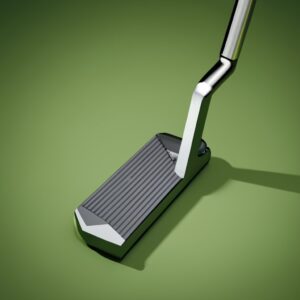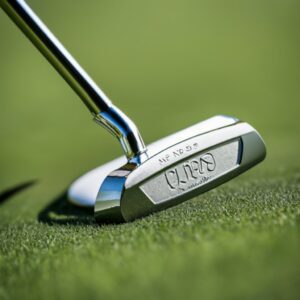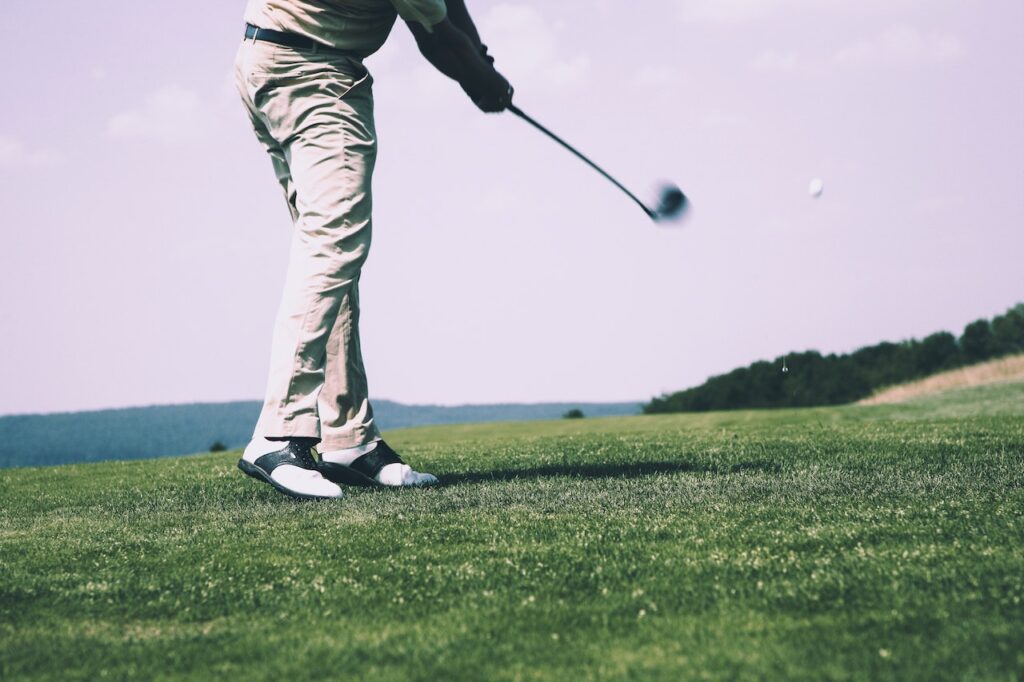Are you a golfer looking to master your putting game? If so, understanding the different types of putters available to you is crucial. One option worth exploring is the heel-shafted putter. In this article, we will delve into what exactly a heel-shafted putter is and the advantages it can bring to your game. With its weight distribution towards the heel, this putter provides enhanced stability and balance, leading to improved accuracy and a consistent stroke. Get ready to elevate your putting skills with the heel-shafted putter in golf.
Key Takeaways
- Heel Shafted putters have a hosel that connects the shaft to the heel of the head.
- Heel Shafted putters are toe-balanced, meaning the toe of the head points towards the ground when balanced on the hand.
- Heel Shafted putters are geared towards golfers with an arced putting stroke.
- Heel Shafted putters help reduce side spin on the ball and provide better stability and balance.
Importance of choosing the right putter
The putter is your key to victory, showing its true value when you’re teeing off on the green, getting ready to send your ball home into the hole. But did you know that not all putters are the same? And most importantly, the putter that suits your friend might not suit you. Why so? Because choosing the right putter depends on your putting style, swing style, and personal preferences.
One specific type of putter that stands out in terms of performance and appeal is the heel-shafted putter.
What is heel-shafted putters?

Picture this, you’re standing on the green, holding your sleek heel-shafted putter. What’s a heel-shafted putter, you ask? Heel-shafted putters are those where the shaft connects to the heel (or the back) of the head.
The design of this type of putter encourages an open-to-close stroke, where the heel and toe of the putter rotate around the centre of the putter during the stroke. This gives a sweeping motion and is ideal for golfers who prefer arc stroke styles.
Famous examples of the heel-shafted putter allow include the iconic Ping Anser and copies of it. They have been proven time and time again to be advantageous for specific kinds of players, especially those who naturally sweep more in their putting strokes.
Some golfers insist that the placement of the shaft in a heel-shafted putter makes it feel more balanced, while others believe it offers a superior weight distribution that leads to more consistent shots. Regardless of the slight nuances in each golfer’s putting stroke, the principle remains the same – consistency is key to lowering your scores.
So, if you are contemplating adding a new club to your golf armory or maybe replacing an old friend, don’t overlook the potential of the dynamic heel-shafted putter. It could be the secret ingredient to your success on the green. Seize the opportunity to explore different putter styles – and remember, each type has its own merit!
Make it your mission to find the best fit for your golfing style. After all, in a sport as nuanced and complex as golf, every little advantage counts. Happy putting to you!
Characteristics of Heel Shafted Putter
A heel-shafted putter provides better stability and balance, reducing side spin on the ball and helping you improve your accuracy on the greens. The hosel type of a heel shafted putter connects the shaft to the heel of the clubhead. This design places more weight towards the heel, which helps golfers who tend to miss putts to the left. The weight distribution and connection to the heel of the clubhead contribute to the stability and balance of the putter. By reducing side spin on the ball, a heel-shafted putter allows for a more consistent stroke, resulting in improved accuracy on the greens. Now that you understand the characteristics and benefits of a heel-shafted putter, let’s explore how to choose the right one for you.
Choosing the Right Heel-Shafted Putter
When you’re gearing up for a game of golf, selecting the right equipment is key. Even the slightest variation in your gear can have a significant impact on your overall performance. And when it comes to putters, a heel-shafted one should not be overlooked.
Favored for its weight distribution, balance, and alignment capabilities, a heel-shafted putter allows you to play your game with precision. It may not be something commonly mentioned in mainstream golf equipment discussions, but it might just be the perfect match to enhance your golf game.
Factors to consider in selecting a heel-shafted putter
The game of golf, like any other sport, requires careful consideration of your gear. So how do you choose the right heel-shafted putter for you?
- Putter Balance: Different putters have different balance points. A heel-shafted putter has a toe hang balance, and is ideal if you have a strong arching stroke.
- Alignment Features: The design and visual positioning guide on a putter can immensely help with alignment. Heel-shafted putters often come with alignment lines or dots to guide your setup.
- Putter Length: This is dependent on your height and posture. A correctly sized putter helps preserve accuracy and consistency in your strokes.
- Personal Comfort: Your putter should feel comfortable and natural in your hands. Always handle the putter before purchase to ensure a good feel and control.
Custom fitting options and working with professionals

Still unsure about choosing the perfect heel-shafted putter? That’s where custom fitting and professional advice come in.
Custom Fitting: Having your putter professionally fitted helps to identify your strengths and weaknesses and match those to a putter that can help enhance your game.
Work With Professionals: Golf pros or coaches can provide insights and suggestions to aid in your selection. They can guide you to make an informed decision tailored to your specific needs and playing style.
Here’s a quick recap of choosing a heel-shafted putter aspects:
| Aspect | Explanation |
|---|---|
| Putter Balance: | Heel-shafted putters are toe hang balanced and are great for players with an arched stroke. |
| Alignment Features: | Putters with alignment aids like lines or dots can help with proper setup. |
| Putter Length: | The correct putter length depends on a player’s height and posture, influencing accuracy in their strokes. |
| Personal Comfort: | The putter should feel comfortable and natural in a player’s hands for improved control. |
| Custom fitting, Professional advice: | Custom fitting helps to match a putter to a player’s specific strengths and weaknesses while professional advice offers insights and suggestions to inform the choice of putter. |
In this journey of polishing your golf skills, you must make sure that your equipment benefits you and not the other way around. You never know, the right decision of a heel-shafted putter might just tee you off to your next big win.
Heel Shafted Putter Techniques
To improve your putting game with a heel shafted putter, focus on proper alignment, grip pressure, eye position, keeping the putter head square, and maintaining a smooth stroke path. When aligning yourself with the target, ensure that your feet, hips, and shoulders are parallel to the target line. This will help you establish a consistent setup and improve your aim. Next, grip the putter with a light to medium pressure, allowing for a relaxed and controlled stroke. Position your eyes directly over the ball to ensure a clear view of the target line. Keep the putter head square throughout the stroke, avoiding any twisting or turning. Finally, maintain a smooth stroke path by using your shoulders and arms, rather than your wrists, to control the movement of the putter. By focusing on these techniques, you will improve your accuracy and consistency with a heel shafted putter.
Heel Shafted Putter Brands
Explore different brands of heel-shafted putters to find one that suits your preferences and helps improve your putting game. When it comes to selecting a heel-shafted putter, there are several reputable brands to consider. Scotty Cameron offers the Select Newport and Select Newport 2, which are known for their sleek design and precision performance. Odyssey, another popular brand, offers the O-Works Red 2-Ball and White Hot Pro 2.0, both of which provide excellent stability and accuracy on the greens. TaylorMade also produces quality heel-shafted putters, such as the Spider Tour Platinum and TP Patina Del Monte. Exploring different brands allows you to compare features, design, and performance to find the perfect heel-shafted putter for your game. So, take your time, try out different options, and elevate your putting skills with a top-notch heel-shafted putter.
How to Improve Putting Game with a Heel-Shafted Putter?
Chances are, if you’re an ardent golfer, you’ve heard of the heel-shafted putter. Unlike the typical center-shafted putters, the shaft of the heel-shafted putter connects at the heel or the end of the putter’s head. It creates a different weight distribution and balance than its center-shafted counterpart, which can significantly affect your game.
Proper Technique for Using a Heel-Shafted Putter
So, you’re fond of the heel-shafted putter and want to learn how best to use it? Here’s how:
Grasp confidently: Hold your heel-shafted putter confidently, with your non-dominant hand closer to the top of the club, and your dominant hand below it. Ensure the grip runs diagonally from the base of your little finger to the pad just below your index finger’s base.
Align with precision: For a proper stance, align your feet, hips, and shoulders parallel to the target line. Your eyes should be directly above or slightly inside the ball. Always remember, it’s the stroke path rather than the alignment of your body that directly influences your putt’s direction.
Tips for Alignment and Maintaining a Square Face
Knowing how to align your putts and maintain a square face with a heel-shafted putter can elevate your golf game to a whole new level.
Master the Alignment: Be as precise as possible with your alignment. Use an intermediate target, such as a discolored piece of grass between you and the hole, to help align your putter face.
Maintain a Square Face: Maintaining a square club face is crucial to achieve desired ball trajectory. It requires constant practice but remember to keep your wrists firm and prevent twisting during your stroke.
Let’s summarize the essential advice in a handy table:
| Techniques & Tips for Heel-shafted Putter | Explanation |
|---|---|
| Properly grasp the putter | Your non-dominant hand should be closer to the top of the club, and your dominant hand beneath it. You should grip it, so the grip runs diagonally in your hand. |
| Aligning your body | Your feet, hips, and shoulders should be parallel to the target line, with your eyes directly above or slightly inside the ball. |
| Master the alignment | Use an intermediate object to help align your face putter face. |
| Maintain a square face | Keep your wrists firm during your stroke to avoid twisting and maintain a square club face. |
With the correct technique and alignment, a heel-shafted putter can help improve your overall putting game and offer a new performance edge on the green. Happy golfing!
Advantages of Center Shafted Putter

Using a center shafted putter can improve your putting accuracy and provide a more consistent roll. Here are three advantages of using a center shafted putter in golf:
- Alignment: A center shafted putter allows for better alignment as the shaft and sightline line up together. This makes it easier to aim and set up your putts accurately.
- Straight Arc: Center shafted putters are designed to suit players with a straight back and straight through stroke. The face balanced design of these putters promotes a straight arc, which helps in maintaining a consistent putting stroke.
- Strike: The alignment of the shaft in the center of the putter makes it easier to hit the ball from the center of the clubface. This improves the contact and ensures a more solid strike, resulting in a more consistent and predictable roll.
Disadvantages of Center Shafted Putter
If you prefer a more traditional design, you might not find the non-traditional look of a center shafted putter appealing. Center shafted putters have their hosel connected to the center or closer to the heel of the head, making them face-balanced. While these putters have their advantages, they also come with a few disadvantages. One of the main disadvantages is the non-traditional design, which may not appeal to some golfers who prefer a more traditional look. Additionally, the shaft in the center makes center shafted putters less forgiving for off-center strikes. This means that if you don’t hit the ball perfectly in the center of the putter face, you may experience a decrease in accuracy and consistency. However, it’s important to note that these disadvantages may not be significant for all golfers, as it ultimately depends on individual preferences and putting styles.
Other Options for Putters
When it comes to putters, there are other options besides the traditional center shafted putters. These alternative options cater to different golfers’ preferences and putting styles. Here are three other options to consider:
- Heel Hosel: This type of putter has the shaft positioned towards the heel of the clubhead. It is suitable for players with an arced putting stroke. The weight distribution towards the heel helps golfers who tend to miss putts to the left and reduces side spin on the ball. The heel hosel design also provides better stability and balance, allowing for a more consistent stroke and improved accuracy on the greens.
- Offset Hosel: With the shaft positioned behind the clubface, offset hosel putters promote hands in front of the clubface at impact. This helps golfers with a tendency to push or slice their putts. The offset design helps to square the face and minimize mishits, resulting in more accurate putts.
- Single Bend or Double Bend Hosels: These putters have a shaft alignment towards the heel, making them face balanced options. Face balanced putters are well-suited for players with a straight back and straight through stroke. They offer a consistent and true roll, promoting a smooth stroke and improved distance control.
These alternative options provide golfers with the opportunity to find a putter that best suits their stroke and preferences. Now, let’s dive into a comparison between center shafted and heel shafted putters.
Comparison Between Center Shafted and Heel Shafted Putters
You may be wondering how center shafted putters compare to heel shafted putters. To help you understand the differences, let’s take a look at a comparison table:
| Center Shafted Putter | Heel Shafted Putter | |
|---|---|---|
| Face Balance | Yes | No |
| Stroke Type | Straight back, straight through | Arc |
| Alignment | Shaft and sightline line up | Clubhead rotation to match stroke |
| Forgiveness | Less forgiving for off-center strikes | More forgiving for off-center strikes |
| Appearance | Non-traditional design | Classic and traditional |
Center shafted putters are face balanced, meaning the face of the club faces upward when balanced on the hand, while heel shafted putters have toe hang, meaning the toe of the head points towards the ground when balanced on the hand. Center shafted putters are ideal for golfers with a straight back and straight through stroke, while heel shafted putters are geared towards golfers with an arced putting stroke.
When it comes to alignment, center-shafted putters have the shaft and sightline lined up together, while heel shafted putters rotate the clubhead to match the player’s stroke. While center-shafted putters may have a non-traditional design that may not appeal to some players, heel shafted putters have a classic and traditional appearance. Consider your stroke type, alignment preferences, and striking forgiveness when choosing between center shafted and heel shafted putters.
Are Center Shafted Putters Face Balanced?
Center shafted putters are typically designed to be face-balanced. Face balance means that when the putter is balanced on a finger or a shaft placed under the grip, the putter face remains parallel to the ground. This design helps promote a straight-back-and-straight-through (SBST) putting stroke, where the putter moves directly along the target line.
However, it’s important to note that variations can exist among different center shafted putter models and brands. While the general design intent is to be face-balanced, golfers should still check the specific specifications of the putter they are interested in to confirm its balance characteristics. Golf manufacturers may produce center shafted putters with slight variations in face balance to cater to different player preferences.
Conclusion
Congratulations! You have now become well-versed in the world of heel-shafted putters. By understanding their unique characteristics and benefits, you can make an informed decision when choosing the perfect putter for your game. With improved accuracy and a consistent stroke, the heel-shafted putter can truly revolutionize your putting skills. So, go out there, confidently select the right heel-shafted putter, and watch as your game reaches new heights.
Frequently Asked Questions
How Does the Weight Distribution of a Heel-Shafted Putter Affect Putting Performance?
The weight distribution of a heel-shafted putter significantly affects your putting performance. It places more weight towards the heel, enhancing stability and balance, reducing side spin, and helping golfers who tend to miss putts to the left.
Are There Any Specific Techniques or Tips for Using a Heel-Shafted Putter Effectively?
To use a heel-shafted putter effectively, focus on proper alignment, grip pressure, eye position, square putter head, and a smooth stroke path. These techniques will improve stability, balance, and accuracy on the greens.
What Are Some Popular and Reputable Brands That Produce Heel-Shafted Putters?
Popular and reputable brands that produce heel-shafted putters include Scotty Cameron, Odyssey, and TaylorMade. These brands offer a variety of models with different features to suit your preferences and improve your putting performance.
Can a Heel-Shafted Putter Help With Reducing Side Spin on the Ball?
A heel-shafted putter can help reduce side spin on the ball, providing better stability and balance. While it may not be the traditional choice, it can improve your accuracy on the greens. Give it a try!
Are There Any Factors Other Than Weight and Design to Consider When Choosing a Heel-Shafted Putter?
When choosing a heel-shafted putter, consider factors beyond weight and design. Factors like shaft placement, head rotation, toe hang, and feel will impact your stroke and overall performance on the greens.

I’m Donna Weiss, and I am the proud writer behind the captivating content you’ll find on golfneedy.com. As an avid golfer and passionate writer, I have combined my two greatest passions to bring you an incredible golfing experience. Through my articles, I aim to provide you with valuable insights, equipment reviews, and updates on the latest tournaments. Whether you’re a seasoned golfer or just starting out on this exciting journey, I am here to guide you and share my expertise. Together, let’s explore the fascinating world of golf, uncovering new techniques, and enhancing our skills. Join me on this thrilling adventure as we elevate our game and embark on an exciting golfing journey. Read More



